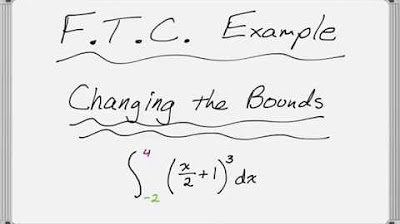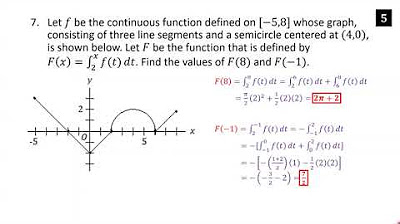Definite Integrals from Graphs (Part 2 of 3) - U-Substitution
TLDRThis video script offers a comprehensive guide to tackling more challenging definite integrals from graphs. The presenter begins by illustrating the property of factoring out a constant multiple in integrals, using the example of integrating from negative six to negative three of two times f(x) dx, which simplifies to zero due to the areas under the graph cancelling each other out. The script then delves into examples involving the factoring out of constants and calculating the integral from negative three to negative one of three times f(x) dx, resulting in a value of 18. The core of the video focuses on u-substitution, a technique for transforming difficult integrals into more manageable forms. This is demonstrated through the integral from negative two to two of f(2x) dx, where the substitution u = 2x simplifies the problem, leading to a final value of 9. Further examples are provided, emphasizing the process of substitution and the importance of considering the graph when calculating areas. The script concludes with an integral from negative six to twenty-one of four times f(x/3) dx, showcasing the application of u-substitution and yielding a final result of 126. The video is an invaluable resource for those looking to master the art of u-substitution and integral calculus.
Takeaways
- 📚 **Factoring Constants**: You can factor out a constant multiple from a definite integral, simplifying the calculation.
- 🔍 **Graph Analysis**: Sometimes, the integral of a function over a specific interval can be determined by analyzing the graph and the areas it encloses.
- ✖️ **Opposite Areas**: If two regions on a graph have the same area but opposite signs, their combined integral can result in zero.
- 📐 **Geometric Interpretation**: The integral can be visualized as the area under a curve, which can be approximated by breaking it down into simpler shapes like squares, triangles, and trapezoids.
- 🔄 **U-Substitution**: U-substitution is a technique used to transform difficult integrals into easier ones by substituting a new variable that simplifies the expression.
- 🔀 **Changing Variables**: When using u-substitution, it's necessary to change the limits of integration and the differential, which involves finding an expression for dx in terms of du.
- ↔️ **Boundary Adjustments**: After applying u-substitution, the original x boundaries must be converted to the new variable u to redefine the limits of integration.
- 📈 **Graph Utilization**: The given graph of the function can be used to calculate the new integral after substitution, making it easier to find areas and evaluate the integral.
- 🔢 **Signed Areas**: When calculating the integral, it's important to consider the signed areas, which take into account the direction of the curve (positive or negative values).
- 🧩 **Piecewise Integration**: Complex integrals can be broken down into simpler regions that can be integrated separately, often resulting in cancellations or easier calculations.
- 📉 **Symmetry in Integrals**: In some cases, symmetrical regions can simplify the calculation because their areas can cancel each other out, simplifying the overall integral.
Q & A
What is the property of definite integrals that allows us to factor out a constant multiple?
-The property of definite integrals that allows factoring out a constant multiple is that the integral of a constant times a function is equal to the constant times the integral of the function over the same interval.
Why did the first example result in a value of zero?
-The first example resulted in a value of zero because the areas under the curve for the regions from negative six to negative three and from negative three to some other point had the same magnitude but opposite signs, thus canceling each other out when summed.
How did the speaker simplify the calculation of the integral from negative 3 to negative 1 of 3 times f of X DX?
-The speaker simplified the calculation by factoring out the constant multiple, which is 3, and then calculating the integral from negative 3 to negative 1 of f of X DX. The result was then multiplied by 3.
What geometric shapes were used to represent the region under the curve in the second example?
-In the second example, a trapezoid and a triangle were used to represent the region under the curve, with the area of the triangle being 2 and the overall region being six units.
What is u-substitution and how is it used in the context of the third example?
-U-substitution is a method used to transform an integral into a simpler one by substituting a new variable u for a function of x within the integral. In the third example, the speaker set u equal to 2x, used differential calculus to express dx in terms of du, and then rewrote the integral in terms of u.
How did the speaker handle the change of the variable and its bounds in the u-substitution method?
-The speaker changed the variable x to u by setting u = 2x and then found the corresponding bounds for u by substituting the original x bounds into the new u expression. The speaker also adjusted dx to be 1/2 du to match the substitution.
What was the result of the integral from negative 2 to 2 of f of 2 X DX after applying u-substitution?
-After applying u-substitution and evaluating the new integral from negative 4 to 4, the result was 1/2 times the sum of the areas represented by a rectangle, a large triangle, and a small triangle, which added up to 18. Thus, the final result was 1/2 * 18, which equals 9.
In the fourth example, what substitution was made for u and how did it affect the integral?
-In the fourth example, the speaker chose u to be x/3. This substitution affected the integral by allowing the speaker to express dx as 3 du, which simplified the integral to 12 times the integral from negative 2 to 7 of f of u du.
How did the speaker calculate the value of the integral from negative 6 to 21 of 4 times f of X over 3 and then DX?
-The speaker used u-substitution with u = x/3, which led to expressing dx as 3 du. The integral was then rewritten as 12 times the integral from negative 2 to 7 of f of u du. The speaker divided the region under the curve into trapezoids and triangles, calculated their areas, and summed them up, resulting in a final value of 126.
What is the significance of the constant multiples in the integrals discussed in the script?
-The constant multiples can be factored out of the integral, simplifying the calculation. This is because the integral of a constant times a function is equal to the constant times the integral of the function, which allows for easier computation of the integral.
How did the speaker use the graph to evaluate the integral in the third example?
-The speaker used the graph to identify the regions under the curve that corresponded to the integral's bounds after u-substitution. By approximating these regions as geometric shapes (rectangle and triangle), the speaker calculated their areas and summed them up to find the value of the integral.
Outlines
📚 Finding Definite Integrals from Graphs
This paragraph introduces the topic of finding more challenging definite integrals using graphs. The speaker begins by discussing the property of definite integrals that allows for the factoring out of a constant multiple. The example given involves integrating from negative six to negative three of two times a function f(x), which simplifies to two times the integral of f(x) from the same bounds. The graph reveals that the areas of the regions considered cancel each other out, resulting in a final answer of zero. The speaker then moves on to another example to further clarify the process.
📈 Evaluating Definite Integrals with Constant Multiples
The second paragraph continues the discussion on evaluating definite integrals, emphasizing the use of constant multiples. The example provided involves integrating from negative three to negative one of three times f(x). The speaker demonstrates how to factor out the constant multiple and then calculate the integral over the given interval. The integral is visualized as a combination of a square and a triangle, leading to a total area of six units. After multiplying by the constant multiple, the final answer is eighteen. The paragraph concludes with the speaker's intention to present another example to further illustrate the process.
Mindmap
Keywords
💡Definite Integrals
💡Graphs
💡Factoring Out a Constant
💡Trapezoid
💡U-Substitution
💡Differential
💡Signed Areas
💡Constants
💡Rectangle
💡Triangle
💡Symmetry
Highlights
The video discusses finding more challenging definite integrals from graphs.
A property of definite integrals allows factoring out a constant multiple.
The first example involves integrating from -6 to -3 of 2 times f(x) dx, resulting in zero due to equal areas with opposite signs.
In the second example, the integral from -3 to -1 of 3 times f(x) dx is calculated as 18 units.
The third example uses u-substitution to transform the integral from -2 to 2 of f(2x) dx into a more manageable form.
The u-substitution method is applied by letting u = 2x and adjusting the integral's bounds and differential.
The transformed integral is evaluated as 1/2 the integral from -4 to 4 of f(u) du, resulting in 9.
The fourth example demonstrates the integral from -6 to 21 of 4 times f(x/3) dx using similar substitution techniques.
The substitution u = x/3 simplifies the integral, which is then evaluated over the bounds -2 to 7.
The integral is broken down into regions consisting of trapezoids and triangles for area calculation.
The signed areas of the regions are summed to find the value of the integral, resulting in 126.
The video emphasizes the importance of understanding u-substitution for solving more complex integrals.
The presenter provides a step-by-step guide on how to apply u-substitution to different types of integrals.
The video concludes by encouraging viewers to practice u-substitution to become more comfortable with the technique.
The method of calculating the area under the curve using rectangles and triangles is explained.
The concept of changing the bounds of integration when using u-substitution is highlighted.
The importance of considering the constant multiples when factoring them out of the integral is discussed.
The video demonstrates how to handle integrals with opposite signed areas that cancel each other out.
The calculation of the integral is shown to involve adding up the areas of different geometric shapes derived from the function's graph.
Transcripts
Browse More Related Video

Fundamental Theorem of Calculus: Changing the Bounds with u-Substitution

Definite Integral With U-Substitution

_-substitution: definite integrals | AP Calculus AB | Khan Academy

Average Value of a Function

AP Calculus AB Crash Course Day 8 - Integration and Riemann Sums

_-substitution: definite integral of exponential function | AP Calculus AB | Khan Academy
5.0 / 5 (0 votes)
Thanks for rating: